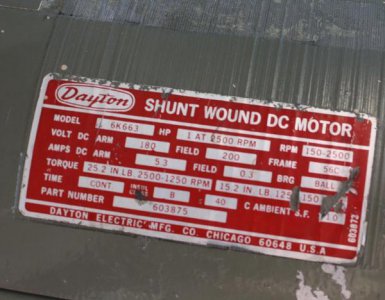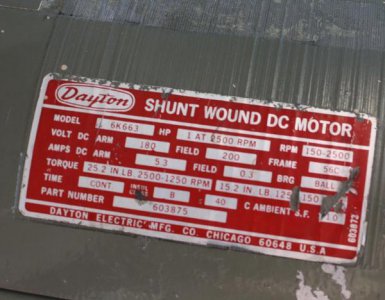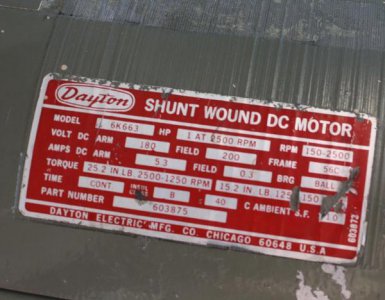-
Welcome back Guest! Did you know you can mentor other members here at H-M? If not, please check out our Relaunch of Hobby Machinist Mentoring Program!
You are using an out of date browser. It may not display this or other websites correctly.
You should upgrade or use an alternative browser.
You should upgrade or use an alternative browser.
Shunt Wound Motor Leads To Reverse Rotation......
- Thread starter calstar
- Start date
- Joined
- Dec 8, 2013
- Messages
- 2,651
To reverse a shunt-wound DC motor you switch *either* A1 and A2 *or* F1 and F2. If you switch both the motor will run in the same direction as it did before you switched them.I know I have to change position of A1 and A2 to reverse the motor rotation but do I also switch F1 and F2? I am using a motor controller with both armature and field connections.
thanks, Brian
Be careful to arrange things so that there is no chance of accidently disconnecting the field while the motor is running and the armature remains connected. That can cause the motor to run away if it is unloaded.
B
British Steel
Forum Guest
Register Today
What John said... Particularly on field loss! Shunt wound motor setups should feature a "Field Loss Relay" - e.g. Monarch 10EEs have 'em:
If you're feeding it AC (which you often can for a shunt-wound motor, they're usually "universal" motors, but check the motor plate) a current transformer on one of the field wires can drive a relay to switch the armature feed, to ensure you don't end up with the motor running away on field loss - using a current transformer rather than just the field voltage will cut the armature current if the field goes open-circuit in a Disaster.
If feeding it DC, a low-value (but high power!) resistor in one of the field wires can be bridged by a relay coil to do the same thing, the relay switching the armature current, be aware that DC puts a lot more strain on the relay contacts, DON'T take the AC rating as gospel!
E.G. for DC if the field's rated at 5A a 1-ohm resistor will have a 5V drop across it, need a 25W or higher rating (so a wire-wound in a nice fat ally case would be good), a 5V coil relay could switch another, heftier, relay's coil current to get the contact current rating you need.
Hope this helps, rather than confuses!
Dave H. (the other one)
If you're feeding it AC (which you often can for a shunt-wound motor, they're usually "universal" motors, but check the motor plate) a current transformer on one of the field wires can drive a relay to switch the armature feed, to ensure you don't end up with the motor running away on field loss - using a current transformer rather than just the field voltage will cut the armature current if the field goes open-circuit in a Disaster.
If feeding it DC, a low-value (but high power!) resistor in one of the field wires can be bridged by a relay coil to do the same thing, the relay switching the armature current, be aware that DC puts a lot more strain on the relay contacts, DON'T take the AC rating as gospel!
E.G. for DC if the field's rated at 5A a 1-ohm resistor will have a 5V drop across it, need a 25W or higher rating (so a wire-wound in a nice fat ally case would be good), a 5V coil relay could switch another, heftier, relay's coil current to get the contact current rating you need.
Hope this helps, rather than confuses!
Dave H. (the other one)
- Joined
- Dec 8, 2013
- Messages
- 2,651
No. That's series motors.If you're feeding it AC (which you often can for a shunt-wound motor, they're usually "universal" motors,
Last edited:
- Joined
- Dec 8, 2013
- Messages
- 2,651
Because something broke. Weakening the field increases speed but decreases torque. Interrupt the field and a whole bunch of energy stored in the field has to go somewhere. Some goes to heat but much of it goes to kinetic energy of the spinning armature: it goes faster, much faster if the motor is large and unloaded. This can cause large motors to explode, making precautions such as field loss relays worthwhile. Small motors with a load always connected will just give a little surge and stop. For your motor I'd just provide the field with its own rectifier wired directly to the motor and connected so that the controller will never have power if it doesn't. Use good quality diodes rated for at least twice the peak line voltage and at least twice the rated field current.How would the field loss occur under typical running conditions?
Field loss is less of an issue with closed-loop controllers because the controller will detect the overspeed condition and kill the armature voltage.
- Joined
- Sep 26, 2013
- Messages
- 408
Because something broke. Weakening the field increases speed but decreases torque. Interrupt the field and a whole bunch of energy stored in the field has to go somewhere. Some goes to heat but much of it goes to kinetic energy of the spinning armature: it goes faster, much faster if the motor is large and unloaded. This can cause large motors to explode, making precautions such as field loss relays worthwhile. Small motors with a load always connected will just give a little surge and stop. For your motor I'd just provide the field with its own rectifier wired directly to the motor and connected so that the controller will never have power if it doesn't. Use good quality diodes rated for at least twice the peak line voltage and at least twice the rated field current.
Field loss is less of an issue with closed-loop controllers because the controller will detect the overspeed condition and kill the armature voltage.
Thanks for the excellent explanation, I understand it now. I don't know how to even began to" provide the field with its own rectifier wired directly to the motor and connected so that the controller will never have power if it doesn't", sounds like a good idea to do it. I did a google search but mostly came up with engineers talking way above my circuit understanding level(limited to say the least). Maybe you can direct me to a website/tutorial that shows/details installation. Always eager to learn!
thanks, Brian
- Joined
- Dec 8, 2013
- Messages
- 2,651
If you use a controller intended for use with shunt-wound motors it will have a pair of terminals for the field and you will be ok.
- Joined
- Apr 30, 2015
- Messages
- 11,280
In other words your controller already has the rectifiers built-in. It doesn't have a fail-safe relay system to cut power if something in the field circuit breaks down. Fancy setups like Monarch EE do.
Mark S.
Mark S.




